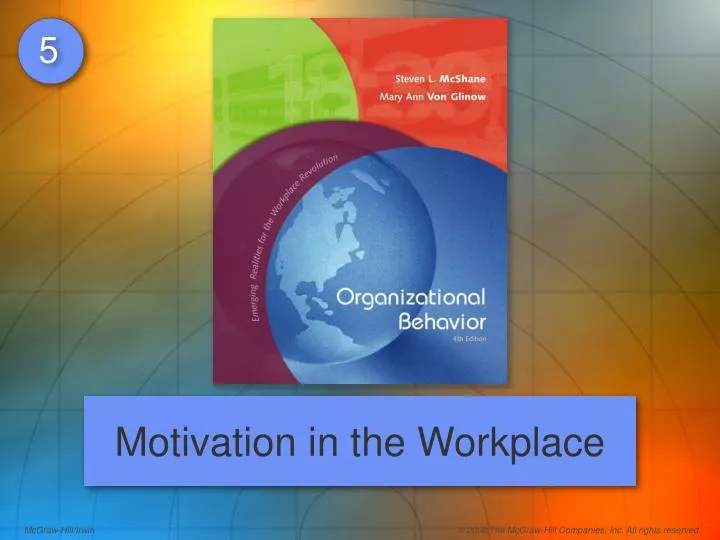

Motivation in the Workplace
Sep 23, 2012
900 likes | 2.16k Views
Motivation in the Workplace. Motivation. Motivation refers to the forces within a person that affect the direction, intensity, and persistence of voluntary behavior.
Share Presentation
- many techniques
- goal setting
- past performance
- social commitments
- esteem belongingness safety physiological
- social identity drive

Presentation Transcript
Motivation Motivation refers to the forces within a person that affect the direction, intensity, and persistence of voluntary behavior. Motivated employees are willing to exert a particular level of effort (intensity) for a certain amount of time (persistence) toward a particular goal (direction).
Challenges of Motivating Employees • Revised employment relationship • Due to globalization, technology, restructuring • Potentially undermines trust and commitment • Flatter organizations • Fewer supervisors to monitor performance • Changing workforce • Gen-X/Gen-Y bring different expectations
Needs, Drives, and Employee Motivation • Needs • Deficiencies that energize or trigger behaviors to satisfy those needs. • Drives • Instinctive or innate tendencies to seek certain goals or maintain internal stability.
Maslow’s Needs Hierarchy Objectives • Holistic • integrative view of needs rather than studying each need in isolation of others • Humanistic • responses to higher needs are influenced by social dynamics, not just instinct • Positivistic • need gratification is just as important as need deprivation
Maslow’s Needs Hierarchy Theory Self-actual-ization Seven categories capture most needs Need to know Need for beauty Five categories placed in a hierarchy Esteem Belongingness Safety Physiological
Deficiencies… Esteem Needs • Recognition (external motivator), Attention (external motivator), Social Status (external motivator), Accomplishment (internal motivator), Self-respect (internal motivator) Social Needs • Friendship, Belonging to a group, Giving and receiving love Safety Needs • Living in a safe area, Medical insurance, Job security, Financial reserves Physiological Needs • Air, Water, Food, Sleep
Self-actual-ization Need to know Need for beauty Esteem Belongingness Safety Physiological Maslow’s Needs Hierarchy Theory • Lowest unmet need has strongest effect • When lower need is satisfied, next higher need becomes the primary motivator • Self-actualization -- a growth need because people desire more rather than less of it when satisfied
Characteristics of Self-Actualized People • Acceptance and Realism: have realistic perceptions of themselves, others and the world around them. • Problem-centering: are concerned with solving problems outside of themselves, including helping others and finding solutions to problems in the external world. • Spontaneity: are spontaneous in their internal thoughts and outward behavior. While they can conform to rules and social expectations, they also tend to be open and unconventional. • Autonomy and Solitude: have the need for independence and privacy. • Continued Freshness of Appreciation: tend to view the world with a continual sense of appreciation, wonder and awe. • Peak Experiences: have what Maslow termed peak experiences, or moments of intense joy, wonder, awe and ecstasy.
Self-actual-ization Need to know Need for beauty Esteem Belongingness Safety Physiological Evaluating Maslow’s Theory • Lack of support for theory • Values influence needs • People have different needs hierarchies -- not universal • Maslow’s categories don’t cover all needs • Needs change more rapidly than Maslow stated
Four-Drive Theory Drive to Acquire • Need to take/keep objects and experiences • Basis of hierarchy and status Drive to Bond • Need to form relationships and social commitments • Basis of social identity Drive to Learn • Need to satisfy curiosity and resolve conflicting information • Basis of self-actualization Drive to Defend • Need to protect ourselves • Reactive (not proactive) drive • Basis of fight or flight
Features of Four Drives • Innate and hardwired -- everyone has them • Independent of each other (no hierarchy of drives) • Complete set -- no drives are excluded from the model
How Four Drives Affect Needs • Four drives determine which emotions are automatically tagged to incoming information • Drives generate independent and often competing emotions that demand our attention • Social skill set determines how to translate drives into needs and effort
Learned Needs Theory • Some needs can be learned • Need for achievement • Desire for challenging and somewhat risky goals, feedback, recognition • Need for affiliation • Desire to seek approval, conform, and avoid conflict • Try to project a favorable self-image • Need for power • Desire to control one’s environment • Personalized versus socialized power
Implications of Needs/Drives Theories • Four-drive theory • provide a balanced opportunity for employees to fulfill drives • employees continually seek fulfillment of drives • avoid having conditions support one drive over others • Maslow • allow employees to self-actualize • power of positive experiences • Offer employees a choice of rewards
Outcomes& Valences P-to-O Expectancy E-to-P Expectancy Effort Performance Expectancy Theory of Motivation Outcome 1 + or - Outcome 2 + or - Outcome 3 + or -
Increasing E-to-P Expectancy • Train employees • Select people with required competencies • Provide role clarification • Provide sufficient resources • Provide coaching and feedback
Increasing P-to-O Expectancy • Measure performance accurately • Describe outcomes of good and poor performance • Explain how rewards are linked to past performance
Increasing Outcome Valences • Ensure that rewards are valued • Individualize rewards • Minimize countervalent outcomes
Goal Setting at Speedera Speedera Networks employees achieved a challenging revenue goal in one quarter, for which all employees in California and India were rewarded with a free Hawaiian trip. Courtesy of Akamai
Specific Relevant Challenging Task Performance Commitment Participation Feedback Effective Goal Setting Task Effort
Goal Difficulty and Performance High Area of Optimal Goal Difficulty Task Performance Low Moderate Challenging Impossible Goal Difficulty
Characteristics of Effective Feedback Specific Effective Feedback Credible Relevant Sufficiently frequent Timely
Supervisor Customer Project leader Co-worker Co-worker Subordinate Subordinate Subordinate Multisource (360-degree) Feedback Evaluated Employee
Executive Coaching • Uses various behavioral methods to help clients identify and achieve goals • Just-in-time personal development using feedback and other techniques • Generally effective, but many techniques make it difficult to pinpoint what is effective
Preferred Feedback Sources • Depends on the situation • Nonsocial sources (gauges, printouts) • Better for goal progress • Considered more accurate, less damaging • Social sources (supervisor, co-workers) • Better for ‘good news’ feedback • Improves self-image and esteem
- More by User
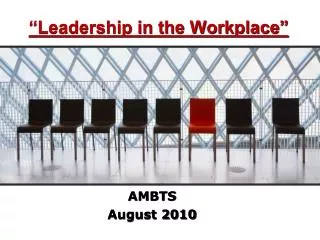
“Leadership in the Workplace”
“Leadership in the Workplace”. AMBTS August 2010. What is Leadership?. Leadership in the Workplace Defined. Leadership is an influence process; therefore, leaders are people who, by their actions, encourage a group of people to move toward a common or shared goal.
4.24k views • 15 slides

Civility in the Workplace
What is Workplace Incivility?. Behaviors with ambiguous intent to harm the target, in violation of workplace norms for mutual respect. Uncivil behaviors are characteristically rude and discourteous, displaying a lack of regard for others. Why should you care about civility?. The Incivility Continuum.
1.94k views • 25 slides

Stress in the Workplace
Stress in the Workplace. Stress in the Workplace. BATs AO1 -Outline the range of sources of workplace stress. AO2/3 - Describe and evaluate research into the workplace as a source of stress- e.g. Johansson, Marmot
3.36k views • 23 slides

Smoking In the Workplace
Smoking In the Workplace. Sample comprised of 270 randomly selected HR professionals. Analyzing 270 out of 2113 emails sent; 2051 received (response rate = 13%). Survey fielded December 7 – 13, 2004; presentation generated on December 14, 2004. Margin of error is +/- 6.0%.
260 views • 4 slides
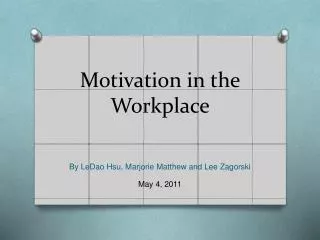
Motivation in the Workplace . By LeDao Hsu, Marjorie Matthew and Lee Zagorski. May 4, 2011. Motivation Research. Please take a few minutes to read over LeDao’s findings and thoughts on motivation. Types of Motivation. Extrinsic Motivation.
515 views • 44 slides
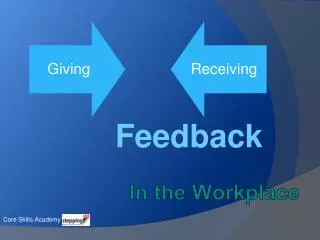
In the Workplace
Receiving. Giving. In the Workplace. Feedback. Core Skills Academy. What is Feedback?. Feedback is information we receive from others defining their perception of us in terms of looks, actions, or things we have said.
401 views • 18 slides

Motivation in the Workplace. Nawal Ahmed Lizette Ramirez-Miranda Madeline Taylor Aisha Trujillo Nasarin Ahmed Pgs. 498-510. If you aren’t fired with enthusiasm You will be fired with enthusiasm. Overview of Presentation. Motivation at work Flow Industrial Organizational Psychology
457 views • 20 slides

Motivation in the Workplace. Motivation Through Recognition. Panfric Hotel general manager David Gachuru (shown in photo giving an award to employee Matayo Moyale) motivates employees with good old-fashioned praise and recognition. Courtesy Sanova Panafric Hotel.
618 views • 41 slides

Health in the Workplace
Health in the Workplace. By: Thunderous Silence. Problems.
199 views • 7 slides

Learning in the Workplace
Learning in the Workplace. Module from SIOP. Learning in the Workplace. (assuming you have held a job) How did you learn how to perform your job? What types of training methods do you think work best? What makes a good teacher / trainer?. Learning in Industrial-Organizational Psychology.
315 views • 7 slides

Motivation in the Workplace. Module from SIOP. Workplace Motivation. Why do people work? Why do other people work ? What motivates you to work harder at work or in school? What de-motivates you? What could your boss or teacher do to get you to work harder?
293 views • 7 slides
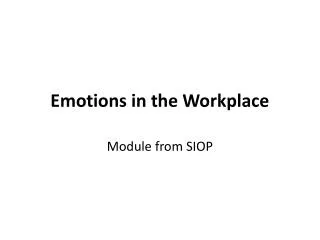
Emotions in the Workplace
Emotions in the Workplace. Module from SIOP. Emotions in the Workplace. Emotions are states of feeling that are often intense, last for only a short time, and are clearly directed at (and caused by) someone or some circumstance.
278 views • 7 slides

Motivation in the Classroom
Motivation in the Classroom. Chapter 11 cont. Motivation in the Classroom cont. Bluebook Assessment #6 – Short Answer Teacher Characteristics Climate Variables Instructional Variables Cultural Influences in Learning . Assessment Strategy #6 Short Answer.
177 views • 8 slides

Motivation in the Workplace. A major resource of companies is their “human capital”. ~ the cost of low employee motivation can be great. In order to be effective in an organizational context, you must know how to diagnose and remediate motivation problems. ~ yours as well as others.
206 views • 6 slides

UNDERSTANDING AND MANAGING MOTIVATION IN THE WORKPLACE
UNDERSTANDING AND MANAGING MOTIVATION IN THE WORKPLACE. III. MOTIVATION. NEEDS THEORIES. NEEDS THEORIES. PROCESS THEORIES. PROCESS THEORIES. PROCESS THEORIES. PROCESS THEORIES.
384 views • 29 slides
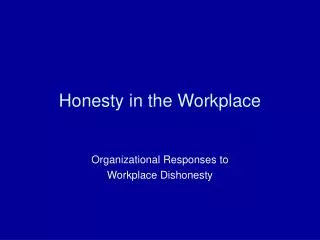
Honesty in the Workplace
Honesty in the Workplace. Organizational Responses to Workplace Dishonesty. Workplace Dishonesty. Theft by Employees Employee theft is estimated to cost $50-200 Billion per year in US 1/3 of business failures and bankruptcies are due at least in part to theft
530 views • 23 slides

Motivation in the Classroom. Chapter 11. Motivation in the Classroom. Learning-focused vs. Performance-focused Self-Regulation Teacher Characteristics Climate or Environment Variables. Learning vs. Performance Focus. Self-regulated students Teacher characteristics Climate Variables
194 views • 8 slides

Motivation in the Classroom. Chapter 11 cont. Motivation in the Classroom cont. Bluebook Assessment #6 – Short Answer Teacher Characteristics Climate Variables Instructional Variables Cultural Influences in Learning. Assessment Strategy #6 Short Answer.
206 views • 8 slides
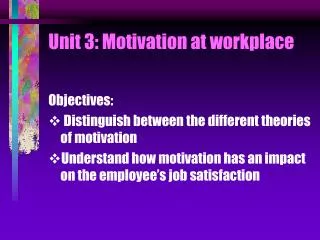
Unit 3: Motivation at workplace
Unit 3: Motivation at workplace. Objectives: Distinguish between the different theories of motivation Understand how motivation has an impact on the employee’s job satisfaction. Definition of Motivation:.
352 views • 15 slides
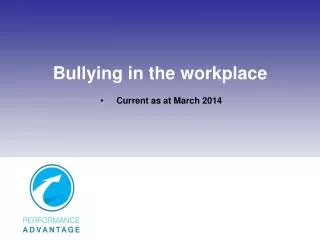
Bullying in the workplace
Bullying in the workplace. Current as at March 2014. Why consider bullying?. Your employees are your organisation’s most valuable asset. Happy employees are productive employees.
323 views • 21 slides
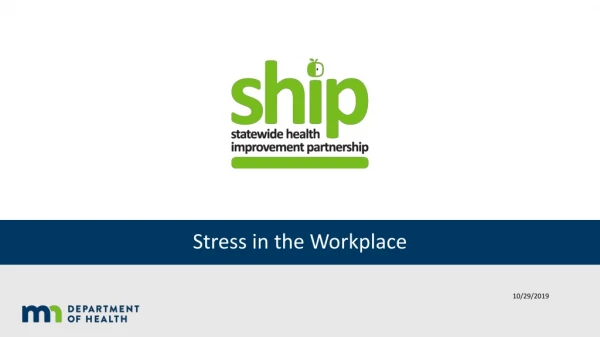
Stress in the Workplace. Workplace Wellness Programs. A recent study of primarily small employers found: 1 80.6% of employers stated they offer WW programs Only 13% actually offer comprehensive WW programs Only 45% of employees surveyed said their workplace offers WW programs
177 views • 14 slides

340 views • 32 slides
The Science of Improving Motivation at Work

The topic of employee motivation can be quite daunting for managers, leaders, and human resources professionals.
Organizations that provide their members with meaningful, engaging work not only contribute to the growth of their bottom line, but also create a sense of vitality and fulfillment that echoes across their organizational cultures and their employees’ personal lives.
“An organization’s ability to learn, and translate that learning into action rapidly, is the ultimate competitive advantage.”
In the context of work, an understanding of motivation can be applied to improve employee productivity and satisfaction; help set individual and organizational goals; put stress in perspective; and structure jobs so that they offer optimal levels of challenge, control, variety, and collaboration.
This article demystifies motivation in the workplace and presents recent findings in organizational behavior that have been found to contribute positively to practices of improving motivation and work life.
Before you continue, we thought you might like to download our three Goal Achievement Exercises for free . These detailed, science-based exercises will help you or your clients create actionable goals and master techniques to create lasting behavior change.
This Article Contains:
Motivation in the workplace, motivation theories in organizational behavior, employee motivation strategies, motivation and job performance, leadership and motivation, motivation and good business, a take-home message.
Motivation in the workplace has been traditionally understood in terms of extrinsic rewards in the form of compensation, benefits, perks, awards, or career progression.
With today’s rapidly evolving knowledge economy, motivation requires more than a stick-and-carrot approach. Research shows that innovation and creativity, crucial to generating new ideas and greater productivity, are often stifled when extrinsic rewards are introduced.
Daniel Pink (2011) explains the tricky aspect of external rewards and argues that they are like drugs, where more frequent doses are needed more often. Rewards can often signal that an activity is undesirable.
Interesting and challenging activities are often rewarding in themselves. Rewards tend to focus and narrow attention and work well only if they enhance the ability to do something intrinsically valuable. Extrinsic motivation is best when used to motivate employees to perform routine and repetitive activities but can be detrimental for creative endeavors.
Anticipating rewards can also impair judgment and cause risk-seeking behavior because it activates dopamine. We don’t notice peripheral and long-term solutions when immediate rewards are offered. Studies have shown that people will often choose the low road when chasing after rewards because addictive behavior is short-term focused, and some may opt for a quick win.
Pink (2011) warns that greatness and nearsightedness are incompatible, and seven deadly flaws of rewards are soon to follow. He found that anticipating rewards often has undesirable consequences and tends to:
- Extinguish intrinsic motivation
- Decrease performance
- Encourage cheating
- Decrease creativity
- Crowd out good behavior
- Become addictive
- Foster short-term thinking
Pink (2011) suggests that we should reward only routine tasks to boost motivation and provide rationale, acknowledge that some activities are boring, and allow people to complete the task their way. When we increase variety and mastery opportunities at work, we increase motivation.
Rewards should be given only after the task is completed, preferably as a surprise, varied in frequency, and alternated between tangible rewards and praise. Providing information and meaningful, specific feedback about the effort (not the person) has also been found to be more effective than material rewards for increasing motivation (Pink, 2011).

They have shaped the landscape of our understanding of organizational behavior and our approaches to employee motivation. We discuss a few of the most frequently applied theories of motivation in organizational behavior.
Herzberg’s two-factor theory
Frederick Herzberg’s (1959) two-factor theory of motivation, also known as dual-factor theory or motivation-hygiene theory, was a result of a study that analyzed responses of 200 accountants and engineers who were asked about their positive and negative feelings about their work. Herzberg (1959) concluded that two major factors influence employee motivation and satisfaction with their jobs:
- Motivator factors, which can motivate employees to work harder and lead to on-the-job satisfaction, including experiences of greater engagement in and enjoyment of the work, feelings of recognition, and a sense of career progression
- Hygiene factors, which can potentially lead to dissatisfaction and a lack of motivation if they are absent, such as adequate compensation, effective company policies, comprehensive benefits, or good relationships with managers and coworkers
Herzberg (1959) maintained that while motivator and hygiene factors both influence motivation, they appeared to work entirely independently of each other. He found that motivator factors increased employee satisfaction and motivation, but the absence of these factors didn’t necessarily cause dissatisfaction.
Likewise, the presence of hygiene factors didn’t appear to increase satisfaction and motivation, but their absence caused an increase in dissatisfaction. It is debatable whether his theory would hold true today outside of blue-collar industries, particularly among younger generations, who may be looking for meaningful work and growth.
Maslow’s hierarchy of needs
Abraham Maslow’s hierarchy of needs theory proposed that employees become motivated along a continuum of needs from basic physiological needs to higher level psychological needs for growth and self-actualization . The hierarchy was originally conceptualized into five levels:
- Physiological needs that must be met for a person to survive, such as food, water, and shelter
- Safety needs that include personal and financial security, health, and wellbeing
- Belonging needs for friendships, relationships, and family
- Esteem needs that include feelings of confidence in the self and respect from others
- Self-actualization needs that define the desire to achieve everything we possibly can and realize our full potential
According to the hierarchy of needs, we must be in good health, safe, and secure with meaningful relationships and confidence before we can reach for the realization of our full potential.
For a full discussion of other theories of psychological needs and the importance of need satisfaction, see our article on How to Motivate .
Hawthorne effect
The Hawthorne effect, named after a series of social experiments on the influence of physical conditions on productivity at Western Electric’s factory in Hawthorne, Chicago, in the 1920s and 30s, was first described by Henry Landsberger in 1958 after he noticed some people tended to work harder and perform better when researchers were observing them.
Although the researchers changed many physical conditions throughout the experiments, including lighting, working hours, and breaks, increases in employee productivity were more significant in response to the attention being paid to them, rather than the physical changes themselves.
Today the Hawthorne effect is best understood as a justification for the value of providing employees with specific and meaningful feedback and recognition. It is contradicted by the existence of results-only workplace environments that allow complete autonomy and are focused on performance and deliverables rather than managing employees.
Expectancy theory
Expectancy theory proposes that we are motivated by our expectations of the outcomes as a result of our behavior and make a decision based on the likelihood of being rewarded for that behavior in a way that we perceive as valuable.
For example, an employee may be more likely to work harder if they have been promised a raise than if they only assumed they might get one.
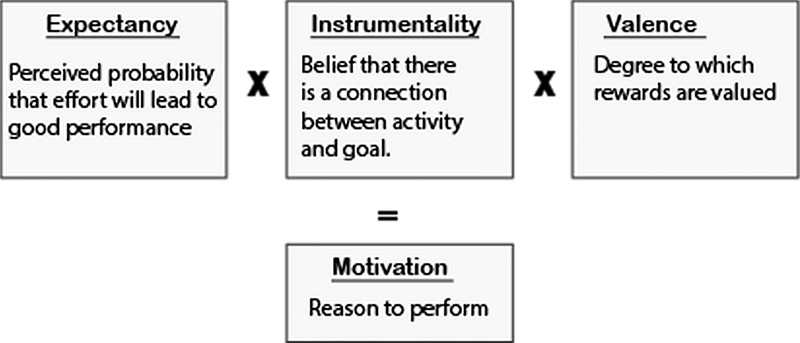
Expectancy theory posits that three elements affect our behavioral choices:
- Expectancy is the belief that our effort will result in our desired goal and is based on our past experience and influenced by our self-confidence and anticipation of how difficult the goal is to achieve.
- Instrumentality is the belief that we will receive a reward if we meet performance expectations.
- Valence is the value we place on the reward.
Expectancy theory tells us that we are most motivated when we believe that we will receive the desired reward if we hit an achievable and valued target, and least motivated if we do not care for the reward or do not believe that our efforts will result in the reward.
Three-dimensional theory of attribution
Attribution theory explains how we attach meaning to our own and other people’s behavior and how the characteristics of these attributions can affect future motivation.
Bernard Weiner’s three-dimensional theory of attribution proposes that the nature of the specific attribution, such as bad luck or not working hard enough, is less important than the characteristics of that attribution as perceived and experienced by the individual. According to Weiner, there are three main characteristics of attributions that can influence how we behave in the future:
Stability is related to pervasiveness and permanence; an example of a stable factor is an employee believing that they failed to meet the expectation because of a lack of support or competence. An unstable factor might be not performing well due to illness or a temporary shortage of resources.
“There are no secrets to success. It is the result of preparation, hard work, and learning from failure.”
Colin Powell
According to Weiner, stable attributions for successful achievements can be informed by previous positive experiences, such as completing the project on time, and can lead to positive expectations and higher motivation for success in the future. Adverse situations, such as repeated failures to meet the deadline, can lead to stable attributions characterized by a sense of futility and lower expectations in the future.
Locus of control describes a perspective about the event as caused by either an internal or an external factor. For example, if the employee believes it was their fault the project failed, because of an innate quality such as a lack of skills or ability to meet the challenge, they may be less motivated in the future.
If they believe an external factor was to blame, such as an unrealistic deadline or shortage of staff, they may not experience such a drop in motivation.
Controllability defines how controllable or avoidable the situation was. If an employee believes they could have performed better, they may be less motivated to try again in the future than someone who believes that factors outside of their control caused the circumstances surrounding the setback.
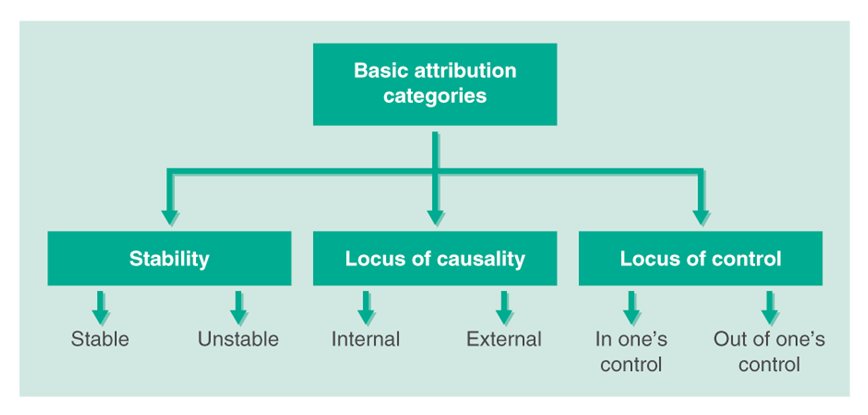
Theory X and theory Y
Douglas McGregor proposed two theories to describe managerial views on employee motivation: theory X and theory Y. These views of employee motivation have drastically different implications for management.
He divided leaders into those who believe most employees avoid work and dislike responsibility (theory X managers) and those who say that most employees enjoy work and exert effort when they have control in the workplace (theory Y managers).
To motivate theory X employees, the company needs to push and control their staff through enforcing rules and implementing punishments.
Theory Y employees, on the other hand, are perceived as consciously choosing to be involved in their work. They are self-motivated and can exert self-management, and leaders’ responsibility is to create a supportive environment and develop opportunities for employees to take on responsibility and show creativity.
Theory X is heavily informed by what we know about intrinsic motivation and the role that the satisfaction of basic psychological needs plays in effective employee motivation.
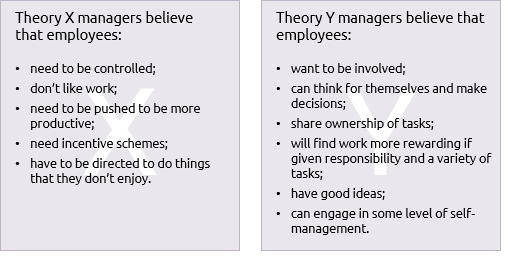
Taking theory X and theory Y as a starting point, theory Z was developed by Dr. William Ouchi. The theory combines American and Japanese management philosophies and focuses on long-term job security, consensual decision making, slow evaluation and promotion procedures, and individual responsibility within a group context.
Its noble goals include increasing employee loyalty to the company by providing a job for life, focusing on the employee’s wellbeing, and encouraging group work and social interaction to motivate employees in the workplace.

There are several implications of these numerous theories on ways to motivate employees. They vary with whatever perspectives leadership ascribes to motivation and how that is cascaded down and incorporated into practices, policies, and culture.
The effectiveness of these approaches is further determined by whether individual preferences for motivation are considered. Nevertheless, various motivational theories can guide our focus on aspects of organizational behavior that may require intervening.
Herzberg’s two-factor theory , for example, implies that for the happiest and most productive workforce, companies need to work on improving both motivator and hygiene factors.
The theory suggests that to help motivate employees, the organization must ensure that everyone feels appreciated and supported, is given plenty of specific and meaningful feedback, and has an understanding of and confidence in how they can grow and progress professionally.
To prevent job dissatisfaction, companies must make sure to address hygiene factors by offering employees the best possible working conditions, fair pay, and supportive relationships.
Maslow’s hierarchy of needs , on the other hand, can be used to transform a business where managers struggle with the abstract concept of self-actualization and tend to focus too much on lower level needs. Chip Conley, the founder of the Joie de Vivre hotel chain and head of hospitality at Airbnb, found one way to address this dilemma by helping his employees understand the meaning of their roles during a staff retreat.
In one exercise, he asked groups of housekeepers to describe themselves and their job responsibilities by giving their group a name that reflects the nature and the purpose of what they were doing. They came up with names such as “The Serenity Sisters,” “The Clutter Busters,” and “The Peace of Mind Police.”
These designations provided a meaningful rationale and gave them a sense that they were doing more than just cleaning, instead “creating a space for a traveler who was far away from home to feel safe and protected” (Pattison, 2010). By showing them the value of their roles, Conley enabled his employees to feel respected and motivated to work harder.
The Hawthorne effect studies and Weiner’s three-dimensional theory of attribution have implications for providing and soliciting regular feedback and praise. Recognizing employees’ efforts and providing specific and constructive feedback in the areas where they can improve can help prevent them from attributing their failures to an innate lack of skills.
Praising employees for improvement or using the correct methodology, even if the ultimate results were not achieved, can encourage them to reframe setbacks as learning opportunities. This can foster an environment of psychological safety that can further contribute to the view that success is controllable by using different strategies and setting achievable goals .
Theories X, Y, and Z show that one of the most impactful ways to build a thriving organization is to craft organizational practices that build autonomy, competence, and belonging. These practices include providing decision-making discretion, sharing information broadly, minimizing incidents of incivility, and offering performance feedback.
Being told what to do is not an effective way to negotiate. Having a sense of autonomy at work fuels vitality and growth and creates environments where employees are more likely to thrive when empowered to make decisions that affect their work.
Feedback satisfies the psychological need for competence. When others value our work, we tend to appreciate it more and work harder. Particularly two-way, open, frequent, and guided feedback creates opportunities for learning.
Frequent and specific feedback helps people know where they stand in terms of their skills, competencies, and performance, and builds feelings of competence and thriving. Immediate, specific, and public praise focusing on effort and behavior and not traits is most effective. Positive feedback energizes employees to seek their full potential.
Lack of appreciation is psychologically exhausting, and studies show that recognition improves health because people experience less stress. In addition to being acknowledged by their manager, peer-to-peer recognition was shown to have a positive impact on the employee experience (Anderson, 2018). Rewarding the team around the person who did well and giving more responsibility to top performers rather than time off also had a positive impact.
Stop trying to motivate your employees – Kerry Goyette
Other approaches to motivation at work include those that focus on meaning and those that stress the importance of creating positive work environments.
Meaningful work is increasingly considered to be a cornerstone of motivation. In some cases, burnout is not caused by too much work, but by too little meaning. For many years, researchers have recognized the motivating potential of task significance and doing work that affects the wellbeing of others.
All too often, employees do work that makes a difference but never have the chance to see or to meet the people affected. Research by Adam Grant (2013) speaks to the power of long-term goals that benefit others and shows how the use of meaning to motivate those who are not likely to climb the ladder can make the job meaningful by broadening perspectives.
Creating an upbeat, positive work environment can also play an essential role in increasing employee motivation and can be accomplished through the following:
- Encouraging teamwork and sharing ideas
- Providing tools and knowledge to perform well
- Eliminating conflict as it arises
- Giving employees the freedom to work independently when appropriate
- Helping employees establish professional goals and objectives and aligning these goals with the individual’s self-esteem
- Making the cause and effect relationship clear by establishing a goal and its reward
- Offering encouragement when workers hit notable milestones
- Celebrating employee achievements and team accomplishments while avoiding comparing one worker’s achievements to those of others
- Offering the incentive of a profit-sharing program and collective goal setting and teamwork
- Soliciting employee input through regular surveys of employee satisfaction
- Providing professional enrichment through providing tuition reimbursement and encouraging employees to pursue additional education and participate in industry organizations, skills workshops, and seminars
- Motivating through curiosity and creating an environment that stimulates employee interest to learn more
- Using cooperation and competition as a form of motivation based on individual preferences
Sometimes, inexperienced leaders will assume that the same factors that motivate one employee, or the leaders themselves, will motivate others too. Some will make the mistake of introducing de-motivating factors into the workplace, such as punishment for mistakes or frequent criticism, but negative reinforcement rarely works and often backfires.

Download 3 Free Goals Exercises (PDF)
These detailed, science-based exercises will help you or your clients create actionable goals and master techniques for lasting behavior change.
Download 3 Free Goals Pack (PDF)
By filling out your name and email address below.
- Email Address *
- Your Expertise * Your expertise Therapy Coaching Education Counseling Business Healthcare Other
- Name This field is for validation purposes and should be left unchanged.
There are several positive psychology interventions that can be used in the workplace to improve important outcomes, such as reduced job stress and increased motivation, work engagement, and job performance. Numerous empirical studies have been conducted in recent years to verify the effects of these interventions.
Psychological capital interventions
Psychological capital interventions are associated with a variety of work outcomes that include improved job performance, engagement, and organizational citizenship behaviors (Avey, 2014; Luthans & Youssef-Morgan 2017). Psychological capital refers to a psychological state that is malleable and open to development and consists of four major components:
- Self-efficacy and confidence in our ability to succeed at challenging work tasks
- Optimism and positive attributions about the future of our career or company
- Hope and redirecting paths to work goals in the face of obstacles
- Resilience in the workplace and bouncing back from adverse situations (Luthans & Youssef-Morgan, 2017)
Job crafting interventions
Job crafting interventions – where employees design and have control over the characteristics of their work to create an optimal fit between work demands and their personal strengths – can lead to improved performance and greater work engagement (Bakker, Tims, & Derks, 2012; van Wingerden, Bakker, & Derks, 2016).
The concept of job crafting is rooted in the jobs demands–resources theory and suggests that employee motivation, engagement, and performance can be influenced by practices such as (Bakker et al., 2012):
- Attempts to alter social job resources, such as feedback and coaching
- Structural job resources, such as opportunities to develop at work
- Challenging job demands, such as reducing workload and creating new projects
Job crafting is a self-initiated, proactive process by which employees change elements of their jobs to optimize the fit between their job demands and personal needs, abilities, and strengths (Wrzesniewski & Dutton, 2001).

Today’s motivation research shows that participation is likely to lead to several positive behaviors as long as managers encourage greater engagement, motivation, and productivity while recognizing the importance of rest and work recovery.
One key factor for increasing work engagement is psychological safety (Kahn, 1990). Psychological safety allows an employee or team member to engage in interpersonal risk taking and refers to being able to bring our authentic self to work without fear of negative consequences to self-image, status, or career (Edmondson, 1999).
When employees perceive psychological safety, they are less likely to be distracted by negative emotions such as fear, which stems from worrying about controlling perceptions of managers and colleagues.
Dealing with fear also requires intense emotional regulation (Barsade, Brief, & Spataro, 2003), which takes away from the ability to fully immerse ourselves in our work tasks. The presence of psychological safety in the workplace decreases such distractions and allows employees to expend their energy toward being absorbed and attentive to work tasks.
Effective structural features, such as coaching leadership and context support, are some ways managers can initiate psychological safety in the workplace (Hackman, 1987). Leaders’ behavior can significantly influence how employees behave and lead to greater trust (Tyler & Lind, 1992).
Supportive, coaching-oriented, and non-defensive responses to employee concerns and questions can lead to heightened feelings of safety and ensure the presence of vital psychological capital.
Another essential factor for increasing work engagement and motivation is the balance between employees’ job demands and resources.
Job demands can stem from time pressures, physical demands, high priority, and shift work and are not necessarily detrimental. High job demands and high resources can both increase engagement, but it is important that employees perceive that they are in balance, with sufficient resources to deal with their work demands (Crawford, LePine, & Rich, 2010).
Challenging demands can be very motivating, energizing employees to achieve their goals and stimulating their personal growth. Still, they also require that employees be more attentive and absorbed and direct more energy toward their work (Bakker & Demerouti, 2014).
Unfortunately, when employees perceive that they do not have enough control to tackle these challenging demands, the same high demands will be experienced as very depleting (Karasek, 1979).
This sense of perceived control can be increased with sufficient resources like managerial and peer support and, like the effects of psychological safety, can ensure that employees are not hindered by distraction that can limit their attention, absorption, and energy.
The job demands–resources occupational stress model suggests that job demands that force employees to be attentive and absorbed can be depleting if not coupled with adequate resources, and shows how sufficient resources allow employees to sustain a positive level of engagement that does not eventually lead to discouragement or burnout (Demerouti, Bakker, Nachreiner, & Schaufeli, 2001).
And last but not least, another set of factors that are critical for increasing work engagement involves core self-evaluations and self-concept (Judge & Bono, 2001). Efficacy, self-esteem, locus of control, identity, and perceived social impact may be critical drivers of an individual’s psychological availability, as evident in the attention, absorption, and energy directed toward their work.
Self-esteem and efficacy are enhanced by increasing employees’ general confidence in their abilities, which in turn assists in making them feel secure about themselves and, therefore, more motivated and engaged in their work (Crawford et al., 2010).
Social impact, in particular, has become increasingly important in the growing tendency for employees to seek out meaningful work. One such example is the MBA Oath created by 25 graduating Harvard business students pledging to lead professional careers marked with integrity and ethics:
The MBA oath
“As a business leader, I recognize my role in society.
My purpose is to lead people and manage resources to create value that no single individual can create alone.
My decisions affect the well-being of individuals inside and outside my enterprise, today and tomorrow. Therefore, I promise that:
- I will manage my enterprise with loyalty and care, and will not advance my personal interests at the expense of my enterprise or society.
- I will understand and uphold, in letter and spirit, the laws and contracts governing my conduct and that of my enterprise.
- I will refrain from corruption, unfair competition, or business practices harmful to society.
- I will protect the human rights and dignity of all people affected by my enterprise, and I will oppose discrimination and exploitation.
- I will protect the right of future generations to advance their standard of living and enjoy a healthy planet.
- I will report the performance and risks of my enterprise accurately and honestly.
- I will invest in developing myself and others, helping the management profession continue to advance and create sustainable and inclusive prosperity.
In exercising my professional duties according to these principles, I recognize that my behavior must set an example of integrity, eliciting trust, and esteem from those I serve. I will remain accountable to my peers and to society for my actions and for upholding these standards. This oath, I make freely, and upon my honor.”
Job crafting is the process of personalizing work to better align with one’s strengths, values, and interests (Tims & Bakker, 2010).
Any job, at any level can be ‘crafted,’ and a well-crafted job offers more autonomy, deeper engagement and improved overall wellbeing.
There are three types of job crafting:
- Task crafting involves adding or removing tasks, spending more or less time on certain tasks, or redesigning tasks so that they better align with your core strengths (Berg et al., 2013).
- Relational crafting includes building, reframing, and adapting relationships to foster meaningfulness (Berg et al., 2013).
- Cognitive crafting defines how we think about our jobs, including how we perceive tasks and the meaning behind them.
If you would like to guide others through their own unique job crafting journey, our set of Job Crafting Manuals (PDF) offer a ready-made 7-session coaching trajectory.
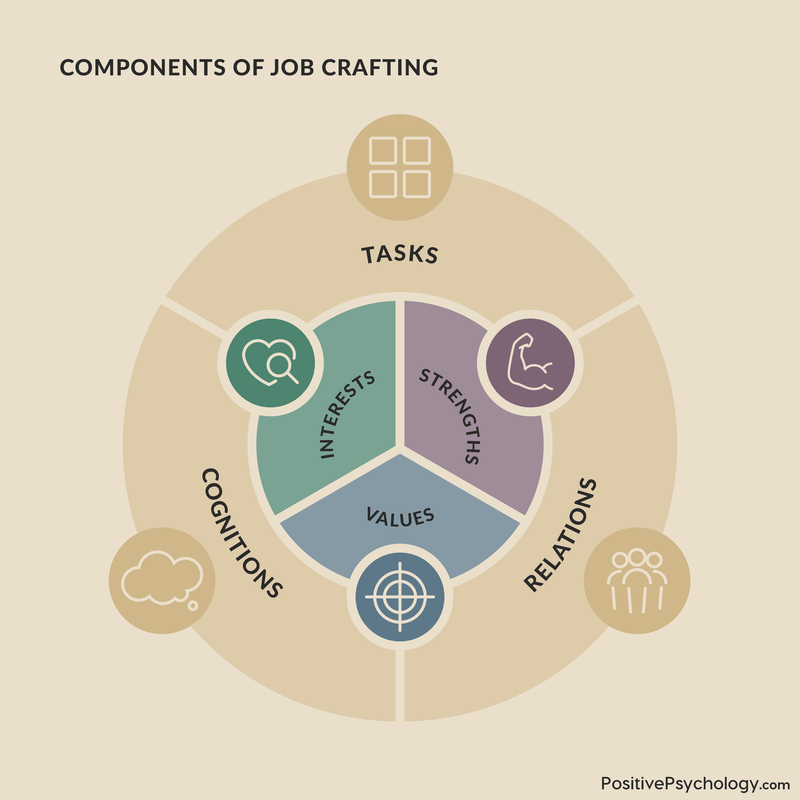
Prosocial motivation is an important driver behind many individual and collective accomplishments at work.
It is a strong predictor of persistence, performance, and productivity when accompanied by intrinsic motivation. Prosocial motivation was also indicative of more affiliative citizenship behaviors when it was accompanied by motivation toward impression management motivation and was a stronger predictor of job performance when managers were perceived as trustworthy (Ciulla, 2000).
On a day-to-day basis most jobs can’t fill the tall order of making the world better, but particular incidents at work have meaning because you make a valuable contribution or you are able to genuinely help someone in need.
J. B. Ciulla
Prosocial motivation was shown to enhance the creativity of intrinsically motivated employees, the performance of employees with high core self-evaluations, and the performance evaluations of proactive employees. The psychological mechanisms that enable this are the importance placed on task significance, encouraging perspective taking, and fostering social emotions of anticipated guilt and gratitude (Ciulla, 2000).
Some argue that organizations whose products and services contribute to positive human growth are examples of what constitutes good business (Csíkszentmihályi, 2004). Businesses with a soul are those enterprises where employees experience deep engagement and develop greater complexity.
In these unique environments, employees are provided opportunities to do what they do best. In return, their organizations reap the benefits of higher productivity and lower turnover, as well as greater profit, customer satisfaction, and workplace safety. Most importantly, however, the level of engagement, involvement, or degree to which employees are positively stretched contributes to the experience of wellbeing at work (Csíkszentmihályi, 2004).

17 Tools To Increase Motivation and Goal Achievement
These 17 Motivation & Goal Achievement Exercises [PDF] contain all you need to help others set meaningful goals, increase self-drive, and experience greater accomplishment and life satisfaction.
Created by Experts. 100% Science-based.
Daniel Pink (2011) argues that when it comes to motivation, management is the problem, not the solution, as it represents antiquated notions of what motivates people. He claims that even the most sophisticated forms of empowering employees and providing flexibility are no more than civilized forms of control.
He gives an example of companies that fall under the umbrella of what is known as results-only work environments (ROWEs), which allow all their employees to work whenever and wherever they want as long their work gets done.
Valuing results rather than face time can change the cultural definition of a successful worker by challenging the notion that long hours and constant availability signal commitment (Kelly, Moen, & Tranby, 2011).
Studies show that ROWEs can increase employees’ control over their work schedule; improve work–life fit; positively affect employees’ sleep duration, energy levels, self-reported health, and exercise; and decrease tobacco and alcohol use (Moen, Kelly, & Lam, 2013; Moen, Kelly, Tranby, & Huang, 2011).
Perhaps this type of solution sounds overly ambitious, and many traditional working environments are not ready for such drastic changes. Nevertheless, it is hard to ignore the quickly amassing evidence that work environments that offer autonomy, opportunities for growth, and pursuit of meaning are good for our health, our souls, and our society.
Leave us your thoughts on this topic.
Related reading: Motivation in Education: What It Takes to Motivate Our Kids
We hope you enjoyed reading this article. Don’t forget to download our three Goal Achievement Exercises for free .
- Anderson, D. (2018, February 22). 11 Surprising statistics about employee recognition [infographic]. Best Practice in Human Resources. Retrieved from https://www.bestpracticeinhr.com/11-surprising-statistics-about-employee-recognition-infographic/
- Avey, J. B. (2014). The left side of psychological capital: New evidence on the antecedents of PsyCap. Journal of Leadership & Organizational Studies, 21( 2), 141–149.
- Bakker, A. B., & Demerouti, E. (2014). Job demands–resources theory. In P. Y. Chen & C. L. Cooper (Eds.), Wellbeing: A complete reference guide (vol. 3). John Wiley and Sons.
- Bakker, A. B., Tims, M., & Derks, D. (2012). Proactive personality and job performance: The role of job crafting and work engagement. Human Relations , 65 (10), 1359–1378
- Barsade, S. G., Brief, A. P., & Spataro, S. E. (2003). The affective revolution in organizational behavior: The emergence of a paradigm. In J. Greenberg (Ed.), Organizational behavior: The state of the science (pp. 3–52). Lawrence Erlbaum Associates.
- Berg, J. M., Dutton, J. E., & Wrzesniewski, A. (2013). Job crafting and meaningful work. In B. J. Dik, Z. S. Byrne, & M. F. Steger (Eds.), Purpose and meaning in the workplace (pp. 81-104) . American Psychological Association.
- Ciulla, J. B. (2000). The working life: The promise and betrayal of modern work. Three Rivers Press.
- Crawford, E. R., LePine, J. A., & Rich, B. L. (2010). Linking job demands and resources to employee engagement and burnout: A theoretical extension and meta-analytic test. Journal of Applied Psychology , 95 (5), 834–848.
- Csíkszentmihályi, M. (2004). Good business: Leadership, flow, and the making of meaning. Penguin Books.
- Demerouti, E., Bakker, A. B., Nachreiner, F., & Schaufeli, W. B. (2001). The job demands–resources model of burnout. Journal of Applied Psychology , 863) , 499–512.
- Edmondson, A. (1999). Psychological safety and learning behavior in work teams. Administrative Science Quarterly , 44 (2), 350–383.
- Grant, A. M. (2013). Give and take: A revolutionary approach to success. Penguin.
- Hackman, J. R. (1987). The design of work teams. In J. Lorsch (Ed.), Handbook of organizational behavior (pp. 315–342). Prentice-Hall.
- Herzberg, F. (1959). The motivation to work. Wiley.
- Judge, T. A., & Bono, J. E. (2001). Relationship of core self-evaluations traits – self-esteem, generalized self-efficacy, locus of control, and emotional stability – with job satisfaction and job performance: A meta-analysis. Journal of Applied Psychology , 86 (1), 80–92.
- Kahn, W. A. (1990). Psychological conditions of personal engagement and disengagement at work. Academy of Management Journal , 33 (4), 692–724.
- Karasek, R. A., Jr. (1979). Job demands, job decision latitude, and mental strain: Implications for job redesign. Administrative Science Quarterly, 24 (2), 285–308.
- Kelly, E. L., Moen, P., & Tranby, E. (2011). Changing workplaces to reduce work-family conflict: Schedule control in a white-collar organization. American Sociological Review , 76 (2), 265–290.
- Landsberger, H. A. (1958). Hawthorne revisited: Management and the worker, its critics, and developments in human relations in industry. Cornell University.
- Luthans, F., & Youssef-Morgan, C. M. (2017). Psychological capital: An evidence-based positive approach. Annual Review of Organizational Psychology and Organizational Behavior, 4 , 339-366.
- Moen, P., Kelly, E. L., & Lam, J. (2013). Healthy work revisited: Do changes in time strain predict well-being? Journal of occupational health psychology, 18 (2), 157.
- Moen, P., Kelly, E., Tranby, E., & Huang, Q. (2011). Changing work, changing health: Can real work-time flexibility promote health behaviors and well-being? Journal of Health and Social Behavior, 52(4), 404–429.
- Pattison, K. (2010, August 26). Chip Conley took the Maslow pyramid, made it an employee pyramid and saved his company. Fast Company. Retrieved from https://www.fastcompany.com/1685009/chip-conley-took-maslow-pyramid-made-it-employee-pyramid-and-saved-his-company
- Pink, D. H. (2011). Drive: The surprising truth about what motivates us. Penguin.
- Tims, M., & Bakker, A. B. (2010). Job crafting: Towards a new model of individual job redesign. SA Journal of Industrial Psychology, 36(2) , 1-9.
- Tyler, T. R., & Lind, E. A. (1992). A relational model of authority in groups. In M. P. Zanna (Ed.), Advances in experimental social psychology (vol. 25) (pp. 115–191). Academic Press.
- von Wingerden, J., Bakker, A. B., & Derks, D. (2016). A test of a job demands–resources intervention. Journal of Managerial Psychology , 31 (3), 686–701.
- Wrzesniewski, A., & Dutton, J. E. (2001). Crafting a job: Revisioning employees as active crafters of their work. Academy of Management Review, 26 (2), 179–201.
Share this article:
Article feedback
What our readers think.
Good and helpful study thank you. It will help achieving goals for my clients. Thank you for this information
A lot of data is really given. Validation is correct. The next step is the exchange of knowledge in order to create an optimal model of motivation.
A good article, thank you for sharing. The views and work by the likes of Daniel Pink, Dan Ariely, Barry Schwartz etc have really got me questioning and reflecting on my own views on workplace motivation. There are far too many organisations and leaders who continue to rely on hedonic principles for motivation (until recently, myself included!!). An excellent book which shares these modern views is ‘Primed to Perform’ by Doshi and McGregor (2015). Based on the earlier work of Deci and Ryan’s self determination theory the book explores the principle of ‘why people work, determines how well they work’. A easy to read and enjoyable book that offers a very practical way of applying in the workplace.
Thanks for mentioning that. Sounds like a good read.
All the best, Annelé
Motivation – a piece of art every manager should obtain and remember by heart and continue to embrace.
Exceptionally good write-up on the subject applicable for personal and professional betterment. Simplified theorem appeals to think and learn at least one thing that means an inspiration to the reader. I appreciate your efforts through this contributive work.
Excelente artículo sobre motivación. Me inspira. Gracias
Very helpful for everyone studying motivation right now! It’s brilliant the way it’s witten and also brought to the reader. Thank you.
Such a brilliant piece! A super coverage of existing theories clearly written. It serves as an excellent overview (or reminder for those of us who once knew the older stuff by heart!) Thank you!
Let us know your thoughts Cancel reply
Your email address will not be published.
Save my name, email, and website in this browser for the next time I comment.
Related articles

Victor Vroom’s Expectancy Theory of Motivation
Motivation is vital to beginning and maintaining healthy behavior in the workplace, education, and beyond, and it drives us toward our desired outcomes (Zajda, 2023). [...]

SMART Goals, HARD Goals, PACT, or OKRs: What Works?
Goal setting is vital in business, education, and performance environments such as sports, yet it is also a key component of many coaching and counseling [...]

How to Assess and Improve Readiness for Change
Clients seeking professional help from a counselor or therapist are often aware they need to change yet may not be ready to begin their journey. [...]
Read other articles by their category
- Body & Brain (48)
- Coaching & Application (57)
- Compassion (26)
- Counseling (51)
- Emotional Intelligence (24)
- Gratitude (18)
- Grief & Bereavement (21)
- Happiness & SWB (40)
- Meaning & Values (26)
- Meditation (20)
- Mindfulness (45)
- Motivation & Goals (45)
- Optimism & Mindset (34)
- Positive CBT (27)
- Positive Communication (20)
- Positive Education (47)
- Positive Emotions (32)
- Positive Leadership (16)
- Positive Psychology (33)
- Positive Workplace (36)
- Productivity (16)
- Relationships (49)
- Resilience & Coping (35)
- Self Awareness (21)
- Self Esteem (37)
- Strengths & Virtues (30)
- Stress & Burnout Prevention (34)
- Theory & Books (46)
- Therapy Exercises (37)
- Types of Therapy (64)

- Email This field is for validation purposes and should be left unchanged.
3 Goal Achievement Exercises Pack

- SUGGESTED TOPICS
- The Magazine
- Newsletters
- Managing Yourself
- Managing Teams
- Work-life Balance
- The Big Idea
- Data & Visuals
- Reading Lists
- Case Selections
- HBR Learning
- Topic Feeds
- Account Settings
- Email Preferences
A Guide to Motivating Yourself at Work
- Rakshitha Arni Ravishankar

Feeling burned out? Use these tips from our authors.
Sixty percent of employees feel emotionally detached from their jobs and 50% report feeling stressed on a daily basis, according to a recent global survey from Gallup. While your first instinct may be to quit your job, it might not be the most sustainable option. Know that you have the agency to create better working conditions for yourself.
- Understand the impact of your work. Take the time to learn how our work contributes to the larger mission of our organization can help us reenter a more positive state of mind.
- Once you know the impact of your work, pick one area or project and overdeliver. A better way to stay engaged and grow in your role is to identify and prioritize the tasks that will be most recognized by your manager and organization.
- Build habits that help you move through the stressful moments. Practice flourishing or connect to your sense of purpose in life and appreciate your accomplishments even during life’s challenging moments.
- Amplify the parts of your job that you do enjoy. Try job crafting. That is redesign your daily tasks to focus on your strengths.
- Figure out what gives you meaning outside work. Work is not the only place we should seek to thrive. Our interests, goals, and aspirations outside of our jobs can be just as meaningful.
My first job was a dream come true. I was working at a news organization, reporting on some of the most important stories in the world. In the beginning, my work gave me a real sense of purpose — I was reporting on stories that mattered. But slowly, my satisfaction faded. I started dreading the long hours. My pay barely covered my living expenses. The more time went by, the more my tasks began to feel monotonous. Six months in, I was entirely disillusioned and demotivated.
- RR Rakshitha Arni Ravishankar is an associate editor at Ascend.
Partner Center

How it works
For Business
Join Mind Tools
Article • 10 min read
How to Motivate Your Team
Energizing your people to achieve good things.
By the Mind Tools Content Team

Your people may have all the expertise in the world but, if they're not motivated, it's unlikely that they'll achieve their true potential.
On the other hand, work seems easy when people are motivated.
Motivated people have a positive outlook, they're excited about what they're doing, and they know that they're investing their time in something that's truly worthwhile. In short, motivated people enjoy their jobs and perform well.
All effective leaders want their organizations to be filled with people in this state of mind. That's why it's vital that you, as a leader and manager, keep your team feeling motivated and inspired. But of course, this can be easier said than done!
In this article, we'll go over the key theories, strategies and tools that you can use to help your people stay enthusiastic about their work.
The Two Types of Motivation
There are two main types of motivation – extrinsic and intrinsic.
Extrinsic motivation is when you use external factors to encourage your team to do what you want. Pay raises, time off, bonus checks, and the threat of job loss are all extrinsic motivators – some positive, some less so.
Intrinsic motivation is internal. It's about having a personal desire to overcome a challenge, to produce high-quality work, or to interact with team members you like and trust. Intrinsically motivated people get a great deal of satisfaction and enjoyment from what they do.
Every team member is different, and will likely have different motivators. So, it's important to get to know your people, discover what motivates them, and find a good mixture of extrinsic and intrinsic motivators, so that you can motivate them successfully.
Benefits of Motivation in the Workplace
You can't directly control a person's interest in his or her job. Of course, an individual does have some responsibility for motivating himself , but you can encourage that process by creating an environment that helps him to become more intrinsically motivated. Individuals, teams and even whole organizations can reap the rewards.
Motivated people are highly adaptable, particularly when it comes to change , and they have a positive attitude at work. They help to spread an organization's good reputation, reduce rates of absenteeism, and improve performance and profit. They also work hard to achieve their goals , and work with a greater sense of urgency than unmotivated people.
Strategies for Motivating Your People
As a manager, you can use the following steps and strategies to create a motivating environment for your team.
Step 1: Check Your Assumptions
You may not realize it, but your management style is strongly influenced by what you believe about your people.
For example, do you think your team members dislike working, and need continuous supervision? Or, do you believe that they're happy to do their jobs, and are likely to enjoy greater responsibility and freedom?
These two fundamental beliefs form the backbone of the team motivation concept Theory X and Theory Y .
Theory X managers are authoritarian, and assume that they need to supervise people constantly. They believe that their team members don't want or need responsibility, and that they have to motivate people extrinsically to produce results.
Theory Y managers believe that their team members want more responsibility and should help make decisions. They assume that everyone has something valuable to offer.
In short, your beliefs about your team members' motivation affect the way you behave toward them. So, it's important to think carefully about how you view your people, and to explore what you believe truly motivates them. (It can help to think about it from your own perspective – would you prefer your own boss to manage you using Theory X or Theory Y? And how long would you stay working for a Theory X manager?)
Step 2: Eliminate Dissatisfaction and Create Satisfaction
Psychologist Fredrick Herzberg said that you can motivate your team by eliminating elements of job dissatisfaction, and then creating conditions for job satisfaction.
In his Motivation-Hygiene Theory , he noted how causes of dissatisfaction often arise from irritating company policies, intrusive supervision, or lack of job security, among others. If you don't address these issues, people won't be satisfied at work, and motivating them will prove difficult, if not impossible.
Once you've removed the elements of job dissatisfaction, you can look at providing satisfaction. Sources of job satisfaction include clear opportunities for advancement/promotion, an increased sense of responsibility, ongoing training and development programs, or simply a feeling of working with purpose .

Step 3: Personalize Your Motivational Approach
Remember, your team is made up of individuals who have their own unique circumstances, backgrounds and experiences. Consequently, each person may be driven by different motivating factors, and be more or less adept at self-motivation . When you make an effort to understand each team member, you can help them stay motivated.
There are a number of tools and strategies that you can use to tailor your approach to motivation – and not all are completely consistent with one another. However, it's important to remember that every individual and situation is different, so make sure that you choose the theory or model that best fits your circumstances.
Let's explore these in more detail:
- Sirota's Three-Factor Theory argues that there are three crucial factors that motivate your people. These are Equity/Fairness , Achievement and Camaraderie . You can help to ensure that your team members remain motivated and positive by incorporating each of these factors into their work.
- McClelland's Human Motivation Theory is subtly different. McClelland believed that we all have three different drivers, the need for Achievement , Affiliation and Power , with one of them being dominant. If you structure your motivators and leadership style around a team member's dominant driver, your efforts should produce good results.
- Maslow's Hierarchy of Needs identifies five needs that we all have, from the most basic to the most complex. These are physiological/bodily , safety , love/belonging , self-esteem , and self-actualization (the sense of doing what you were born to do). Maslow's Hierarchy is usually presented in a pyramid – you place the basic needs at the bottom, because you need to meet these before you can address any of the more complex ones. According to this approach, you can motivate your team by addressing all of the levels.
- Amabile and Kramer's Progress Theory highlights how progressing and achieving small "wins" can be motivating. It suggests six things you can provide – clear goals and objectives , autonomy , resources , time , support , and the ability to learn from failure – that give people the best chance of making recognizable and meaningful progress at work.
- You can also use Expectancy Theory to create a strong, motivating work environment where high performance is standard. It clarifies the relationship between effort and outcome , and you can use it to tailor motivational rewards to individuals' preferences.
- According to the Pygmalion Effect , your expectations can affect your team members' performance. For example, when you doubt that someone will succeed, you can make her feel undervalued and you undermine her confidence. The Pygmalion Effect is useful because it reinforces the idea that you can encourage people to perform better at work by having and communicating high expectations of them.
- Of course, money does matter, and Understanding Strategic Compensation can help you structure your team's extrinsic rewards. Whether you reward people with increases in base, performance or group-performance pay, understanding the differences between them, and their inherent benefits, can help you structure financial compensation in a more motivating way.
Step 4: Use Transformational Leadership
Motivation is vital in the workplace, but this will only take you so far, and then leadership takes over (click here to visit the Mind Tools leadership section). Once you've used the motivational approaches we've discussed above, you need to take the next step towards becoming an inspirational, transformational leader .
When you adopt this leadership style, you can motivate and lift your team to new heights, and help it to achieve extraordinary things. Transformational leaders expect great things from their team members, and they spark feelings of trust and loyalty in return.
To become a transformational leader, you need to create an attractive, inspiring vision of a meaningful future, encourage people to buy into this vision, manage its delivery, and continue to build trusting relationships with your team members. Set aside time to develop your own leadership skills, and focus on your own personal development, so that you can become an inspiring role model for your people.
As a manager, your goal is to keep your team members motivated and enthusiastic about their work. It's important to strike a balance between extrinsic motivators, such as pay raises and changes to working conditions, and intrinsic motivators, like assigning people tasks that they enjoy.
First, analyze your own assumptions about your people. It's important to remember that they will likely respond more positively when you use a participatory style of management, where they have responsibility and can make their own decisions.
Next, use Herzberg's Motivators and Hygiene Factors to eliminate any causes of dissatisfaction among your team members, and then take steps to introduce elements of satisfaction.
Everyone is different, so tailor your motivational approach to each team member. There are many strategies and tools that you can use but, the more you know and understand each individual, the more effective your efforts will be.
Finally, remember the importance of leadership in motivating your team members and encouraging them to exceed their expectations. By taking steps to become a transformational leader, you can encourage loyalty and trust, and inspire, support and recognize others. More than this, you can inspire them to achieve extraordinary things.
You've accessed 1 of your 2 free resources.
Get unlimited access
Discover more content
Quick tips to motivate your team.
Get The Best From Your Team By Empowering Them to Thrive
Book Insights
No Excuses! The Power of Self-Discipline
Brian Tracy
Add comment
Comments (0)
Be the first to comment!

Get 20% off your first year of Mind Tools
Our on-demand e-learning resources let you learn at your own pace, fitting seamlessly into your busy workday. Join today and save with our limited time offer!
Sign-up to our newsletter
Subscribing to the Mind Tools newsletter will keep you up-to-date with our latest updates and newest resources.
Subscribe now
Business Skills
Personal Development
Leadership and Management
Member Extras
Most Popular
Newest Releases

Pain Points Podcast - Balancing Work And Kids

Pain Points Podcast - Improving Culture
Mind Tools Store
About Mind Tools Content
Discover something new today
Pain points podcast - what is ai.
Exploring Artificial Intelligence
Pain Points Podcast - How Do I Get Organized?
It's Time to Get Yourself Sorted!
How Emotionally Intelligent Are You?
Boosting Your People Skills
Self-Assessment
What's Your Leadership Style?
Learn About the Strengths and Weaknesses of the Way You Like to Lead
Recommended for you
The power of nice.
Robin Koval
Expert Interviews
Business Operations and Process Management
Strategy Tools
Customer Service
Business Ethics and Values
Handling Information and Data
Project Management
Knowledge Management
Self-Development and Goal Setting
Time Management
Presentation Skills
Learning Skills
Career Skills
Communication Skills
Negotiation, Persuasion and Influence
Working With Others
Difficult Conversations
Creativity Tools
Self-Management
Work-Life Balance
Stress Management and Wellbeing
Coaching and Mentoring
Change Management
Team Management
Managing Conflict
Delegation and Empowerment
Performance Management
Leadership Skills
Developing Your Team
Talent Management
Problem Solving
Decision Making
Member Podcast
Module 6: Motivation in the Workplace
Introduction to motivation in the workplace, what you’ll learn to do: discuss impact of motivation in the workplace.
So far in this module, we’ve discussed the components of motivation and some of the most well-known and useful motivational theories. There are more theories out there, and we could go on for quite a while describing them. However, it’s important for managers to understand that all of them seek to predict human behavior and understand the mystery that is motivation, and that all of them bring some amount of clarity to the issue.
Now it’s time to dig in to how exactly motivation impacts the workplace.

Contribute!
Improve this page Learn More
- Introduction to Motivation in the Workplace. Authored by : Freedom Learning Group. Provided by : Lumen Learning. License : CC BY: Attribution
- Untitled. Authored by : Annie Spratt. Provided by : Unsplash. Located at : https://unsplash.com/photos/QckxruozjRg . License : CC BY: Attribution . License Terms : Unsplash License


How it works
Transform your enterprise with the scalable mindsets, skills, & behavior change that drive performance.
Explore how BetterUp connects to your core business systems.
We pair AI with the latest in human-centered coaching to drive powerful, lasting learning and behavior change.
Build leaders that accelerate team performance and engagement.
Unlock performance potential at scale with AI-powered curated growth journeys.
Build resilience, well-being and agility to drive performance across your entire enterprise.
Transform your business, starting with your sales leaders.
Unlock business impact from the top with executive coaching.
Foster a culture of inclusion and belonging.
Accelerate the performance and potential of your agencies and employees.
See how innovative organizations use BetterUp to build a thriving workforce.
Discover how BetterUp measurably impacts key business outcomes for organizations like yours.
A demo is the first step to transforming your business. Meet with us to develop a plan for attaining your goals.

- What is coaching?
Learn how 1:1 coaching works, who its for, and if it's right for you.
Accelerate your personal and professional growth with the expert guidance of a BetterUp Coach.
Types of Coaching
Navigate career transitions, accelerate your professional growth, and achieve your career goals with expert coaching.
Enhance your communication skills for better personal and professional relationships, with tailored coaching that focuses on your needs.
Find balance, resilience, and well-being in all areas of your life with holistic coaching designed to empower you.
Discover your perfect match : Take our 5-minute assessment and let us pair you with one of our top Coaches tailored just for you.

Best practices, research, and tools to fuel individual and business growth.
View on-demand BetterUp events and learn about upcoming live discussions.
The latest insights and ideas for building a high-performing workplace.
- BetterUp Briefing
The online magazine that helps you understand tomorrow's workforce trends, today.
Innovative research featured in peer-reviewed journals, press, and more.
Founded in 2022 to deepen the understanding of the intersection of well-being, purpose, and performance
We're on a mission to help everyone live with clarity, purpose, and passion.
Join us and create impactful change.
Read the buzz about BetterUp.
Meet the leadership that's passionate about empowering your workforce.
For Business
For Individuals
Work motivation: what it is and why it is important

Thrive in your workplace
Connect with our Coaches to build stronger workplace relationships and cultivate a culture that drives success.
It is easy to believe that motivation is a feeling that shows up when we need to perform, leaving us waiting for that magical sensation to appear. When it doesn’t, we’re left to blame all of our missed deadlines or wishes for the lack of it.
So what is motivation?
What is motivation?
Motivation is the driving force that propels us toward something we need or care about. It could be as small as a dry throat motivating you to get a glass of water to calm your thirst. It could be as big as a commitment to a friend to do an Ironman together motivating you to swim in the bay before dawn every day. In this way, motivation is a force that spurs us to action and to see things through to completion.
Motivation is how we get things done when we have an objective we care about. That sounds logical and easy, except that we are also exceptionally good at losing motivation, even when we know we need something.
Types of motivation
Though there are many types of motivation , they generally fall under one of two categories: intrinsic motivation and extrinsic motivation.
Extrinsic motivation
Also known as “carrot and stick” motivation, extrinsic motivators are external . They can be rewards such as money, or avoiding negative impact such as losing your job. With extrinsic motivation, we have little to no control over the positive or negative consequences themselves. But we are motivated to manage the areas we do have control over to either gain or avoid these consequences.
Intrinsic motivation
When we are intrinsically motivated , we complete a task for the enjoyment or feeling of satisfaction we get from doing so. Unlike extrinsic motivators, this type of motivation is not rewarded by external factors. The benefits of employing intrinsic motivation in the workplace include higher levels of employee satisfaction and lower turnover rates.

Why is motivation important in the workplace?
On the surface, the impact of a well-motivated workforce is clear. Motivated employees are more productive. As we mentioned above, though, it goes further than that. Aside from the effectiveness of your teams, motivation is also shown to drive retention and improve company culture.
Let’s break down the ways a motivated workplace benefits both employees and the business.
How motivation benefits the organization
- Meet and exceed the company’s goals. Without a motivated workplace , companies could struggle to deliver on promises to customers, fail to execute daily operations, and let opportunities for the future slip away--talent will avoid demotivated workplaces.
- Higher productivity. Happy employees experience 31 percent higher productivity. Improved employee satisfaction which can lead toward a positive growth for the company.
- Championship. Motivated employees are often emotionally connected to their companies. Emotionally connected employees are 3 times more likely to become brand ambassadors.
- Delighted customers. Workers put in extra effort leading to more output and better solutions.
- Quality. Quality improves as staff take a greater pride in their work.
- Committed, experienced employees. A motivated workplace leads to higher level of staff retention and reduced turnover.
How motivation benefits the individual
- Self-efficacy and confidence in one’s ability to succeed at challenging work tasks
- Increased proactivity and creativity
- Optimism and positive attributions about the future of one’s career or company
- Hope and redirecting paths to work goals in the face of obstacles
- Resilience in the workplace and bouncing back from adverse situations
How meaning impacts motivation
Motivation is all the factors that encourage individuals to be committed to and interested in doing something over time. The feeling of intense interest and desire to act can be momentary. It lets you know you are going in the right direction, but the different aspects that drove you to feel that way are the ones that will maintain your actions.
These factors can be different from one person to another. Find them by answering these questions:
- What do I value?
- Why do I value it?
- What makes me feel vital?
- What makes me feel committed?
- What makes what I am doing purposeful?
In coaching, I have come across many people who didn’t feel motivated at work. The first symptom was a sense of loss of meaning. So when we face demotivation in the workplace, we need to start by asking what the value behind the task is.
Motivation is highly related to the meaning we assign to what we are doing. Many times that meaning is not related to the immediate results of our work or to the specific task. We assign meaning based on a larger outcome or bigger purpose we see in the work.
For example, you can feel passionate about building your own business but also dislike marketing activities. You might be highly motivated to do unpleasant marketing tasks because you know how much your business growth will depend on them. Connecting the task of promoting your business to your goal of growing it, and reminding yourself of that connection, can keep you going with better energy and attitude.
When employees don’t feel as committed or connected to part of something important , when they can’t relate to the mission of the company or simply can’t see the importance of their role at a bigger scale, they often lose motivation.

Most common causes of workplace demotivation
Some of the most common demotivators at work are fairly mundane and even trivial. They seem addressable but the degree to which they are experienced is symptomatic of a larger disconnect in purpose , meaning, and values.
- Micromanagement
- Lack of progress or growth opportunities
- Job insecurity
- No confidence in company leadership
- Poor communication
- Unpleasant coworkers
- Boredom
Although all of these factors are huge motivation killers, they are likely to affect us less when the person feels a deeper connection to what they do.
Notice also what isn’t on the list of demotivators: “difficult projects,” “ambiguity and uncertainty,” “long hours,” and “high expectations.” Although these factors can create stress for the individual, it is the type of stress that facilitates growth and learning . As long as the work or outcome is somewhat interesting or important to the individual, challenges, complexity, and stretch assignments tend to be far more motivating than easy or predefined work.
Tapping into individual motivation through curiosity, desire to make more impact, and inclination to connect with others on something larger than themselves creates a vitality that benefits both the organization and the individual.
How to increase self-motivation at work
1. renew your motivation.
Motivation needs to be refreshed , sometimes daily. When we don’t get an immediate reward, or experience pleasure by avoiding a tedious task, it is important to remind ourselves why what we are doing is relevant or contributes to something more relevant. How? Take it to the next level and always find the bigger purpose. Focus on quality
2. Be aware of the value of your work and what it reflects about you
Take pride in your craftsmanship, even when the situation prioritizes quantity--make your work the best it can be in the circumstances. Many times, we set countable goals, such as finishing 20 invoices. When we do so, we focus only on reaching the number and are less likely to pay attention to what we are doing and enjoying the process.
3. Let role models inspire you
Having someone we look up to can be a powerful way to get motivated. However, it can also be frustrating if we only focus on what they accomplished and forget the HOW. Don’t envy the person; don’t idealize. Learn more about what took them where they are and let them inspire you. Whether they are a co-worker or a famous CEO, learn their stories.
4. Organize your goals
It may seem obvious, but sometimes we forget to break down our goals into manageable actions . Smaller, frequent wins can create momentum as long as they are meaningful and clearly point toward the longer-term objective. Especially when we have too much on our plate, we tend to lose focus of what and why exactly we are doing things. To stay connected to your goal, you must have a clear vision of how every step you take is taking you closer.
5. Harness your self-compassion
Few things can diminish motivation faster than self-doubt and negative self-talk . We cannot get everything right all the time. So try to be kind to yourself when mistakes happen.

How to motivate employees
Keeping yourself motivated is its own challenge. Trying to motivate employees and teams is quite another. It takes a specific skillset and the ability to leverage a variety of leadership skills. Here are eight tips for motivating your team through both uncertain and more predictable landscapes.
1. Demonstrate interest
Ask, listen, and deliver. If you want to motivate a team member, ask them what they care about. What do they need to feel included? For your employees to feel heard, it is not enough for you to ask questions but to actually listen, provide feedback and demonstrate with actions that you take into account.
2. Coach and support
When employees don’t need to worry about controlling the perceptions of managers and colleagues, they are more likely to openly ask for feedback and provide feedback. The energy of freely working together without politics or maneuvering is incredibly rewarding and motivating. Coaching leadership and context support, promote psychological safety in the workplace. This allows you to create a trust-based relationship with your employees, thus increasing satisfaction and motivation for both sides.
3. Value individual and team contributions at a broader level
Raise awareness of the impact each team member has at a bigger level by talking about how their work influenced the management goals, for example. How is every role related to accomplishing the company’s mission? Ask them questions that generate reflection and facilitate a broader view of how their actions impact and contribute to the global operation of the company.
4. Build a positive work environment
Both motivation and demotivation can be contagious. Create a positive environment by setting an example. Say hello to everyone, ask them about their families, make jokes, bring appetizers to the meetings, and be vigilant about maintaining your own authentic enthusiasm and motivation. It is okay to dip or be discouraged occasionally, but model for your team how you continue to find your own motivation.
5. Be aware of your employees and their well-being within the company
Encourage your team members to work together and support each other. Help them see how they can benefit from learning from their colleagues and coaching each other, with healthy competition.
6. Empower your employees
Trust them and motivate them to take some initiative. Allow them to bring ideas and give them the freedom to make decisions without having to consult you, always leaving the door open for questions and coaching. Invite them to the planning and goal-setting process .
7. Address employees' quality of life
Support work-life balance by knowing your employees and letting them put their family and health as a priority. If someone asks to arrive late to attend their daughter's recital or to attend a medical appointment, say yes. Thankful employees are more likely to overachieve. On the other hand, make sure that the demands are challenging enough to avoid boredom but feasible enough to allow your employees to have a life after work.
8. Invest in career pathing
Make every step meaningful. Whether to learn or to apply for a promotion, your employee should feel that everything they are doing will translate into growth, experience, and mobility . Make sure you have talked to them about their future and to coach them into turning work into a learning process that feels meaningful.
Am I motivating my employees enough?
One of the best ways to measure the effectiveness of your motivation techniques is by frequently asking yourself some questions about your team:
- Are they taking the initiative?
- Are they united as a team?
- Do they provide feedback?
- Do they show interest and engagement during meetings?
Other, more traditional, ways to measure motivation can be informative but are often lagging measures. By the time you see them, it’s too late. However, they can still provide insight that helps you understand the full picture.
How to measure work motivation
These formal ways to understand and shape motivation include:
- Performance reviews . They will not only allow you to measure performance but to motivate them by going through the details of what is working for them and what isn’t. They are also a great opportunity to talk about the impact of their work and understand what they value and what makes them feel motivated.
- Employee motivation and engagement surveys . When anonymously answered, they tend to be a great reflection of the workplace environment. Combining a quantitative questionnaire and some open questions will allow you to pick up a good sample of what your employees' motivation and engagement stand at.
- Employee turnover and absenteeism. Are you having a high rate of employee turnover or absenteeism ? These two important metrics raise flags that reflect the motivation and satisfaction of our workforce.
Sustaining workplace motivation
Measuring your employee motivation and your own level of drive at work is the first step. Once you have a baseline, you can put some of these initiatives into practice to embrace a culture of motivation. Though workplace motivation is not a constant –– everyone has tough days –– being mindful and proactive in your approach will set you and your team up for long-term success.
Paulina Cal y Mayor Galindo
BetterUp Fellow Coach
What causes a lack of motivation? Plus 9 tips to get it back
Why the secret to great coaching lies in motivation, goal-setting theory: why it’s important, and how to use it at work, what moves you understanding motivation is your key to success, 10 exciting career change ideas (with salaries), how to use motivational interview questions to drive change, work the motivation: 10 ways to keep your team inspired, work ethics: 5 tips for managers to develop strong teams, 41 tips to stay motivated even when it gets tough, similar articles, how building trust is the true secret to motivating sales teams, what is altruism (and is it important at work), how to handle a lack of motivation at work, ready to be inspired here are 11 self-motivation examples, no motivation to work: 7 tips to find motivation again, what is intrinsic motivation definition and examples, a guide for using motivation to achieve goals, stay connected with betterup, get our newsletter, event invites, plus product insights and research..
3100 E 5th Street, Suite 350 Austin, TX 78702
- Platform Overview
- Integrations
- Powered by AI
- BetterUp Lead
- BetterUp Manage™
- BetterUp Care™
- Sales Performance
- Diversity & Inclusion
- Case Studies
- Why BetterUp?
- About Coaching
- Find your Coach
- Career Coaching
- Communication Coaching
- Life Coaching
- News and Press
- Leadership Team
- Become a BetterUp Coach
- BetterUp Labs
- Center for Purpose & Performance
- Leadership Training
- Business Coaching
- Contact Support
- Contact Sales
- Privacy Policy
- Acceptable Use Policy
- Trust & Security
- Cookie Preferences

- Customer Favourites
Employee Motivation Powerpoint Presentation Slides
Powerpoint Templates
Icon Bundle
Kpi Dashboard
Professional
Business Plans
Swot Analysis
Gantt Chart
Business Proposal
Marketing Plan
Project Management
Business Case
Business Model
Cyber Security
Business PPT
Digital Marketing
Digital Transformation
Human Resources
Product Management
Artificial Intelligence
Company Profile
Acknowledgement PPT
PPT Presentation
Reports Brochures
One Page Pitch
Interview PPT
All Categories

- You're currently reading page 1

Stages // require(['jquery'], function ($) { $(document).ready(function () { //removes paginator if items are less than selected items per page var paginator = $("#limiter :selected").text(); var itemsPerPage = parseInt(paginator); var itemsCount = $(".products.list.items.product-items.sli_container").children().length; if (itemsCount ? ’Stages’ here means the number of divisions or graphic elements in the slide. For example, if you want a 4 piece puzzle slide, you can search for the word ‘puzzles’ and then select 4 ‘Stages’ here. We have categorized all our content according to the number of ‘Stages’ to make it easier for you to refine the results.
Category // require(['jquery'], function ($) { $(document).ready(function () { //removes paginator if items are less than selected items per page var paginator = $("#limiter :selected").text(); var itemsperpage = parseint(paginator); var itemscount = $(".products.list.items.product-items.sli_container").children().length; if (itemscount.
- 3D Man (31)
- Anatomy (2)
- Block Chain (2)
- Branding (3)
- Business Plans (44)
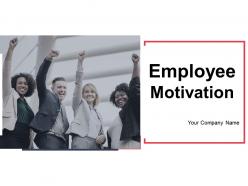

IMAGES
VIDEO
COMMENTS
Motivation in the Workplace. Motivation in the Workplace. Nawal Ahmed Lizette Ramirez-Miranda Madeline Taylor Aisha Trujillo Nasarin Ahmed Pgs. 498-510. If you aren’t fired with enthusiasm You will be fired with enthusiasm. Overview of Presentation. Motivation at work Flow Industrial Organizational Psychology. 455 views • 20 slides
The Science of Improving Motivation at Work. 14 Jan 2020 by Beata Souders, MSc., PsyD candidate. Scientifically reviewed by Maike Neuhaus Ph.D. All motivation comes from within, whether it is triggered by rewards or endeavors that enhance our self-image or intrinsically motivating activities that we engage in for no reward other than the ...
Work motivation presentation design assists users to segment and clarify the topic. This topic-oriented employee satisfaction PowerPoint template is a helpful tool to encourage long term employee retention and engagement. Besides that, presentation layout is completely customizable. You can add or delete the content as needed.
Practice flourishing or connect to your sense of purpose in life and appreciate your accomplishments even during life’s challenging moments. Amplify the parts of your job that you do enjoy. Try ...
Intrinsic motivation is internal. It's about having a personal desire to overcome a challenge, to produce high-quality work, or to interact with team members you like and trust. Intrinsically motivated people get a great deal of satisfaction and enjoyment from what they do. Every team member is different, and will likely have different motivators.
This self-derived motivation, in turn, is linked to feelings of well-being and engagement as well as declines in distress and improvements in positive behaviors at work (Motivation and Emotion, Vol. 42, No. 5, 2018). The meta-analysis included studies from multiple countries, including Iran, the Philippines, Korea, Bulgaria, Holland, China, New ...
What you’ll learn to do: Discuss impact of motivation in the workplace. So far in this module, we’ve discussed the components of motivation and some of the most well-known and useful motivational theories. There are more theories out there, and we could go on for quite a while describing them. However, it’s important for managers to ...
How motivation benefits the individual. Self-efficacy and confidence in one’s ability to succeed at challenging work tasks. Increased proactivity and creativity. Optimism and positive attributions about the future of one’s career or company. Hope and redirecting paths to work goals in the face of obstacles.
Grab our aesthetically pleasing Motivation at Work PowerPoint template to present measures and tips to motivate employees to put in their best performance to accomplish their occupational goals. Our exquisitely designed slides complemented with well-researched content will save you time and make your presentations a huge success!
Slide 1 of 6. Employee Motivation Incentives In Powerpoint And Google Slides Cpb. Slide 1 of 2. Letter of appreciation icon for employee motivation. Slide 1 of 2. Icon for employee seeking motivation at work. Slide 1 of 2. Action plan for employee motivation comprehend ppt powerpoint presentation diagram.